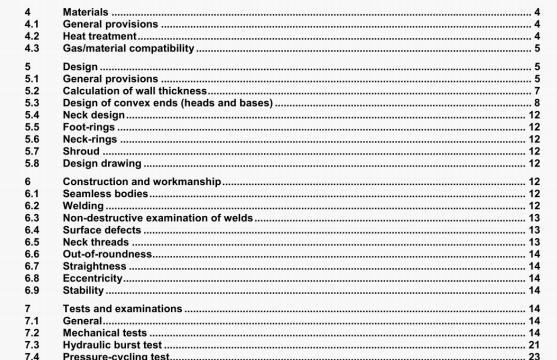ISO 20703 pdf download – Gas cylinders – Refillable weldedaluminium-alloy cylinders -Design,construction and testing.
6.6 Out-of-roundness
The out-of-roundness of the cylindrical shell, i.e. the difference between the maximum and minimum outside
diameters at the same cross-section, shall not exceed 2 % of the mean of these two diameters.
6.7 Straightness
The maximum deviation of the cylindrical part of the shell from a straight line shall not exceed 10 mm per metre length.
6.8 EccentrIcity
When measured on the same cross-section of a cylmder, the minrium and maxirnun, wall thicknesses of the shell shall not deviate by more than 10 % from the average of these two thicknesses, However, for cylinders with a wall thickness of less than 4 mm, the difference between the minimum and maximum wall thicknesses of the shell measured on the same cross-section shall be less than or equal to 0.8 mm,
6.9 StabilIty
For a cylinder designed to stand on its base, the deviation from vertical shall be less than 1 % of its height, and the outer diameter of the surface in contact wth the ground shall be greater than 75 % of the nominal outside diameter (Do).
7 Tests and examinations
7.1 General
Every cylinder submitted to any test shall be identifiable to the batch, and either to the welder and welding mactiw,e, or in the case of an automatic machine to the welding machine
7.2 Mechanical tests
7.2.1 General requirements
All mechanical tests for checking the quality of the metal used for gas cylinders shall be carried out on material taken from cylinders on which all operations affecting mechanical properties have been completed. They do not need to have been pressure tested.
The mechanical tests shall be camed out in accordance with 1.2.2 to 7.2.8, ISO 6892 and ISO 6506-1.
7.2.2 Types of test and evaluation of test results
The number, the localization and type of test specimens shall be taken as shown in Figure 3 and the tests shall be performed as specified in 7.2.3 to 7.2.8 If the cylinder is a sphere or has a design where a dome anctior a base does not exist, specimens shall be taken according to the requirements for the cylinder sidewall.
7.2.3 Tensile test on parent material
7.2.3.1 The test piece on which the tensde test is carried out shall conform to the provisions of ISO 6892. The two faces of the test piece corresponding to the internal and extemal walls of the cylinder shall not be mactuned.
7.2.3.2 The elongation after fracture shall not be less than 12 %.
7.2.3.3 The value obtained for tensile strength shall not be less than R9. The value obtained for the yield stress (R), as defmed in 3.1.1, during the tensile test shall not be less than R.
7.3.2.3 The burst test shall not cause fragmentation & the cylinder. The cylinder shall remain in one piece.
7.3.2.4 The main tear shall not be of a brittle type In addition, for cylinders of actual wall thickness less than 13 mm other than spherical cylinders, the fractt,-e shall be acceptable only if it conforms to the fdlowing description.
— The edges of the fracture shall not be radial but shall be sloping In relation to a diametrical plane and shall display a contraction.
At each end of the fracture, a maximum of two branches shall be allowed and in this case the shorter branch at each end shall be less than 20mm ng
— The fracture shall not extend more than 90’ around the cwcumference on either side of its main part.
— The fracture shall not extend into those parts of the cylinder of thickness more than 1.5 times the maximum thickness measured halfway up the cylinder. For cylinders with convex bases, the fracture shall not reach the centre of the cylinder base.
For cylinders of actual wall thickness over 13 mm. the greater part of the fracture shall be longitudinal.
7.3.2.5 The tear shall not reveal any obvious defect in the metal.
7.4 Pressure-cyclIng test
7.4.1 Cylinders subØcted to this test shall bear markings in accordance with ISO 13769.
7.4.2 This test shall be carried out with a non-corrosive liquid. Cylinders which are guaranteed by the manufacturer to be reasonably representative of the minimum values specified in the design shall be subØcted to successive reversals at an upper cyclic pressure which is equal to the hydraulic test pressure (p11). The cylinders shall withstand 12 000 cycles without failure.
The value of the lower cyclic pressure (pa) shall not exceed 10% of the test pressure (ph)
The cylinder shall actually experience the maximum and minimum cyclic essures during the test.
ISO 20703 pdf download – Gas cylinders – Refillable weldedaluminium-alloy cylinders -Design,construction and testing
